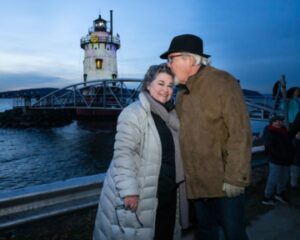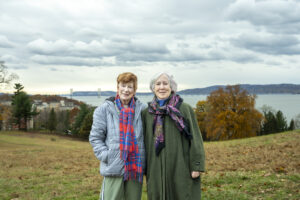 Ken Wray left office in March after 14 years as Sleepy Hollow’s mayor following his election loss to Martin Rutnya. The following is an “exit interview” with Wray written by his wife, Lynn Moffat.
Ken Wray left office in March after 14 years as Sleepy Hollow’s mayor following his election loss to Martin Rutnya. The following is an “exit interview” with Wray written by his wife, Lynn Moffat.
Lynn Moffat: Mayor Wray is dead. Long live Citizen Ken. How does that sound?
Ken Wray: I’m fine with it. Citizen Ken will go to Yankee games on Tuesdays. I think it will be a smooth transition. I’ve had positive conversations with Mayor Rutyna. It looks to me that he supports many of the plans that are in place, and I am available to him if he has questions. I speak for both you and me in wishing him complete success.
Lynn: Is there anything that you’ll miss?
Ken: It was an honor to be elected mayor, even though the workload was stupendous. Bringing the public together with planners, designers, engineers and funders for the Common was an extraordinary process. It was exciting when we got pieces of this jigsaw puzzle to fit. The Common, the Riverwalk, reclaiming the Pocantico shoreline, restoring our downtown — all critical for Sleepy Hollow’s future. Seeing them through to completion would have been fun.
Lynn: The village is carving out a new identity and that’s big stuff. It’s certainly not a company town anymore.
Ken: The big issue for me was (and is) securing major support from New York State while establishing a strong public-private partnership with Edge [on Hudson]. The village is developing a dynamic funding stream with tremendous multiplier effects that will lead to sustainable finances. Unlike some towns that depend on gentrification for renewal, I have said from my first days as mayor that the businesses and residents who were here through the tough times, their boats will rise with the tide. This transformation must work for all. Public spaces, designed properly, go a long way toward fostering equity.
Lynn: The comprehensive plan revealed how intuitive village residents are. To state that the future is dependent on stewardship of Sleepy Hollow’s natural beauty and that care given to our historic, artistic and literary legacies — that is truly forward-thinking. But there are legacies that deserve more attention.
Ken: Explain.
Lynn: Look at our signage: “Village of Sleepy Hollow/Settled in 1640.” Settled by whom? Dutch Patroons owning African slaves. Historic Hudson Valley has made a start to shine a light on slavery’s stain at the [Philipsburg] Manor. And long before 1640, the Weckquaesgeck tribe had numerous settlements in the Hudson Valley.
Ken: Also stated in the comprehensive plan is the goal to make Sleepy Hollow a place where social and environmental justice is valued. There is serious work ahead.
Lynn: You and I have lived here for 25 years. Now we have four generations of Moffats and Wrays. Some will rest in the Sleepy Hollow Cemetery.
Ken: Hmmm, speaking of deceased fathers, I had a tough relationship with mine.
Lynn: Uh-oh. Where are you going with this?
Ken: I admired his work with the California State Park Commission. He was put on the board by Gov. Pat Brown, Jerry’s dad, back in the early ’60’s. The commission wasn’t looking at any land south of L.A. It was all about preserving the Redwoods. Dad argued that though Orange County (where we lived) was only ranches and orange groves, it was going to see enormous growth and the beaches would need. protection from development. He wanted to ensure public access. The Orange County coast system now includes six state parks. The only place you’ll find Dad’s name is in the minutes of the commission’s meetings. There’s no plaque; he left only footprints. But it’s a great legacy.
Lynn: Anything else?
Ken: Yes. Mayor Rutyna said that Sleepy Hollow is fortunate not to be burdened by national political party affiliations — thank you, Unite Sleepy Hollow for making that happen. What will you miss?
Lynn: The free exchange of ideas that the Public Space Council had with Charles McKinney, Margie Ruddick and the Riverwalk designers; working with Anthony and the DPW guys on the street trees along Beekman; doing the videos with Tim and Bill; the Historical Society and the Village planning the 150th anniversary. I hope the Circus comes back and it’s a huge success.
Ken: We can watch it all. It’s not like we’re leaving Sleepy Hollow. Let’s continue to enjoy, and support where we can, the places that make Sleepy Hollow a nice place to hang my iconic hat.
Lynn Moffat and Ken Wray met at Columbia University as undergraduates in the 1970’s, en route to Shea Stadium to see Tom Seaver pitch against Steve Carlton. They have lived in Sleepy Hollow since 1996, when the Yankees won the World Series after a 17-year drought.







I remember taking this photo, making sure that the Mayor and his wife, Lynn looked great. It was a privilege to work with the two of you! It was awesome to have a mayor who values artists and the impact we have on the community. Thanks, Ken!
Ken and Lynn – Sleepy Hollow owes you a big debt of gratitude for all of your tireless work over the last 16+ years to help improve and develop our community. Your public leadership will be missed.
Now you have more time to enjoy your Yankees, and more importantly – your children and grandchildren.
Looking forward to seeing you around town.
Tom Andruss, Village of Sleepy Hollow Trustee